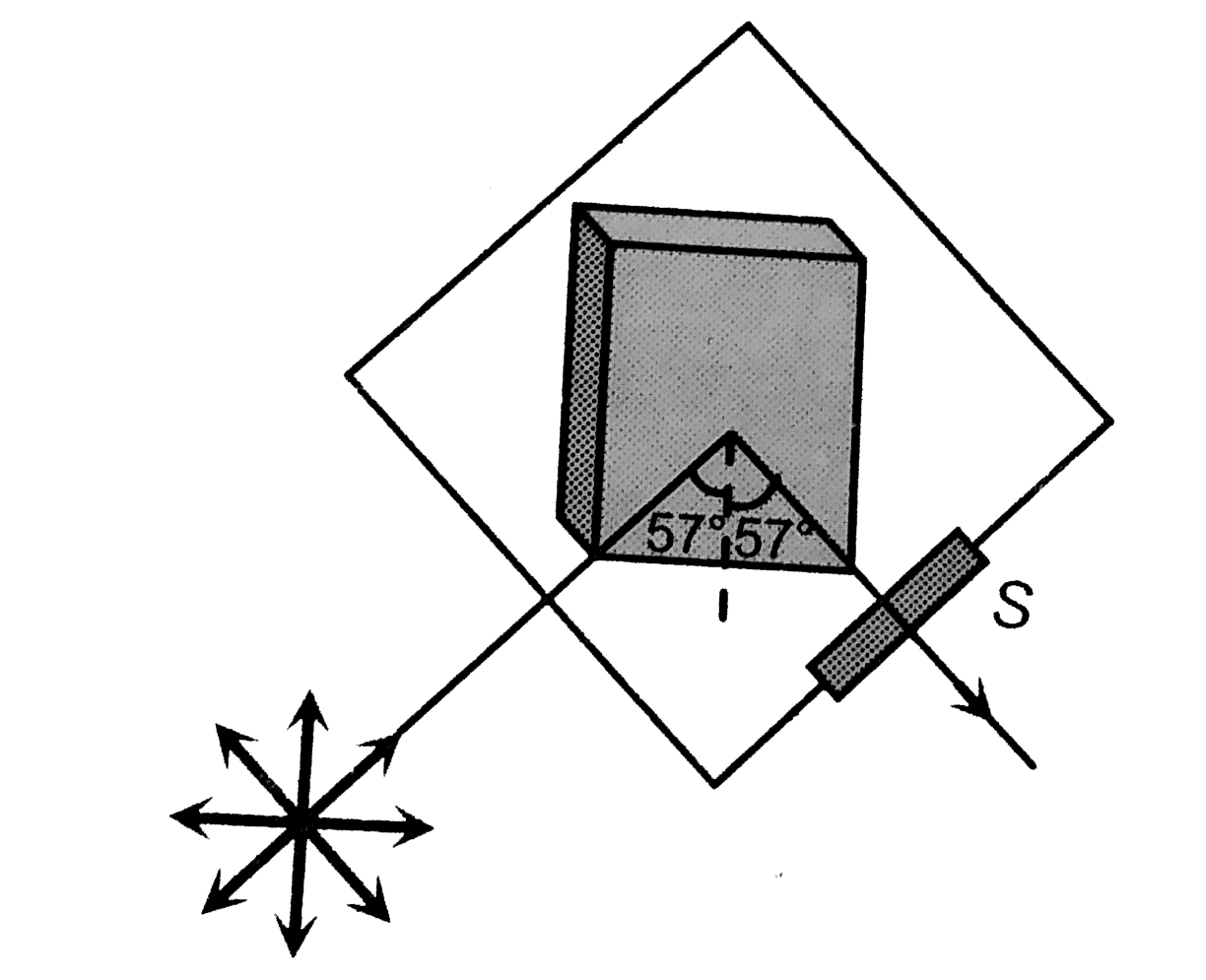Figure represents a glass plate placed vertically on a horizontal table with a beam of unpolarised light falling on its surface at the polarising angle of 57∘ with the normal. The electric vector in the reflected light on screen S will vibrate with respect to the plane of incidence in a

(a) Vertical plane
(b) Horizontal plane
(c) Plane making an angle of 45∘ with the vertical
(d) Plane making an angle of 57∘ with the horizontal
The correct Answer is:A
When unpolarised light is made incident at polarising angle, the reflected light is plane polarised in a direction perpendicular to the plane of incidence.
Therefore →E in reflected light will vibrate in vertical plane with respect to plane of incidence.
Topper's Solved these Questions
- BOOK - A2ZCHAPTER - WAVE OPTICSEXERCISE - Problems Based On Different Concepts39videos
WAVE OPTICS
- BOOK - A2ZCHAPTER - WAVE OPTICSEXERCISE - Section B - Assertion Reasoning23videos
WAVE OPTICS
- BOOK - A2ZCHAPTER - WAVE OPTICSEXERCISE - Young'S Double Slit Experiment111videos
WAVE OPTICS
- BOOK - A2ZCHAPTER - SOURCE AND EFFECT OF MAGNETIC FIELDEXERCISE - Section D - Chapter End Test30videos
SOURCE AND EFFECT OF MAGNETIC FIELD
Similar Questions
A beam of natural light falls on the surface of glass at an angle of 45∘. Using the Fresnel equations, find the degree of polarization of
(a) reflected light,
(b) refracted light.View SolutionA beam of plane-polarized light falls on the surface of water at the Brewster angle. The polarization plane of the electric vector of the electromagnetic wave makes an angle φ=45∘ with the incidence plane. Find the reflection coefficient.
View Solution
Knowledge Check
- Question 1 - Select One
A ray of unpolarised light is incident on a glass plate at the polarising angle of 57∘ .
Now,Aboth the reflected and transmitted rays will be completely polarisedBthe reflected ray will be completely polarised and transmitted ray will be partially polarisedCthe reflected ray will be partially polarised and transmitted ray will be completely polarisedDboth the reflected and transmitted rays will be partially polarised - Question 2 - Select One
A ray of unpolarised light is incident on a glass plate at the polarising angle θp. Then
AThe reflected ray and transmitted rays both will be completely polarisedBThe reflected ray will be completely polarised and the transmitted ray will be partially polarisedCThe reflected ray will be partially polarised and the completely ray will be partially polarisedDThe refected and transmitted rays both will be partially polarised. - Question 3 - Select One
A ray of unpolarised light is incident on a glass plate at the polarizing angle of 57∘. Now,
Aboth the reflected and transmitted rays will be completely polarisedBthe reflected ray will be completely polarised and transmitted ray will be partially polarisedCthe reflected ray will be partially polarised and transmitted ray will be completely polarisedDboth the reflected and the transmitted rays will be partially polarised.
Light is incident on a glass surface at polarising angle of 57.5∘ Then the angle between the incident ray and the refracted ray is
View SolutionIf unpolarized light falls on a glass plate (μ=1.54) at an incidence angle of 57∘, the reflected light is
View SolutionIf unpolarized light falls on a glass plate (μ=1.54) at an incidence angle of 57∘, the reflected light is
View SolutionWhen unpolarised light beam is incident from air onto glass (n=1.5) at the polarising angle
View SolutionWhen unpolarised light beam is incident from air onto glass ( n = 1.5) at the polarising angle
View Solution

